Since the conference was in Boston, I thought that a lot of people from Delaware would be able to make it. After all, it was only a 6 hour drive... But then, a certain "economic meltdown" happened, and my colleagues ended up staying home. As the LMS Project Leader, I was the only one lucky enough to get my trip approved.
The Sakai community builds up a lot of energy during the now annual international conference, so I took upon myself to champion the idea (people on the weekly conference call could hardly stop me from yapping... sorry about that!) of getting as much information out of the conference to the rest of the community who could not make it, including my UD colleagues. It all started with a call for volunteer Citizen Journalists about a week before the conference (if you know nothing about citizen journalism, see this ELI 7 things you need to know file).
Conference Preparation: Building-Up Awareness
One aspect that needed some attention was building-up awareness about the use of social technologies during the conference. Like every decent conference, we needed an easy and short hashtag. #Sakai09 was selected and promoted, along with prefered social media sites and technologies. After debating what should be done, the following technologies were targeted for the conference:- Confluence: The Sakai community wiki space is a blessing the during the whole year, but seems to have a limited role to play during the conferences. Past conferences have shown us that when a lot of people try to use it at the same time, it tends to crash and leave us hanging, so we used it a lot before the conference to promote it, and used a lot of other sites during the conference to "spread the load".
- Facebook, LinkedIn: Events were created on social and profesional networking sites to invite people to register for the conference.
- Twitter: Since a lot of people in the Sakai community are tech-savvy and heavy Twitterers, we knew that Twitter would be a very efficient way to direct people's attention to interesting stuff in real time.
- Youtube: The Mecca of free video could not be ignored. We created a channel called Sakaivideo where Citizen Journalists would upload short videos throughout and after the conference.
- Slideshare: Slides as attachments on the Sakai Confluence wiki are nice, but it seems like they don't get enough attention. Slideshare is a premium free slide sharing service that let users tag, favorite, comment on, and embed slide deck, which was exactly what was needed to spread the knowledge a bit more. A slideshare event was also created to centralize all the slides in one place.
- Vimeo: For longer videos, since they don't impose a lenght limit like Youtube.
- Ustream: The Ustream channel was created in advance and linked from the social media page.
- Yahoo!Pipes: I built a Pipe to gather stuff tagged with Sakai09 from different sources (Diigo, Delicious, Youtube, Flickr, etc.) and embedded the results on the home page of the conference Confluence page. This way, attendees could get a sense of live social presence. The pipe was also a great way to aggregate all these knowledge chunks from different sources in one comprehensive stream.
Short Videos
The biggest problem with conference videos in general is that they are usually too long. Another one is that the audio is not that great, and you lose a lot of questions from the audience most of the time. As one of my ex-colleague used to say: all bad movies are too long.So instead of taking a capture everything approach, we decided to let Citizen Journalists decide on what to record, while trying to capture summaries of key sessions through one-on-one interviews. A lot of people signed-up, and Flip cameras were distributed to most of these people in order to gather short stories about the most interesting projects, opinions, visions, and people. A lot of folks also brought their own high-end video hardware and expertise, including Kim from UNC Chapel Hill (see the pic below).
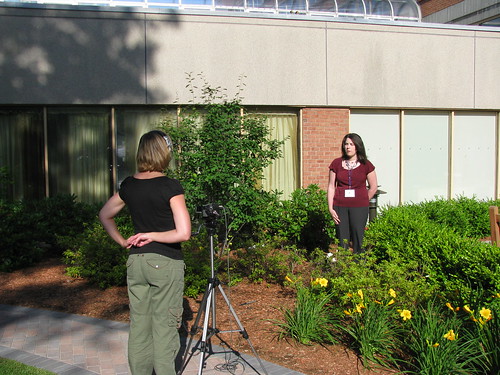
As of today (July 23, 2009), 40 short videos have been uploaded to the Youtube channel, some of which have been viewed more that 100 times. Below are two samples from these videos.
Longer videos were uploaded to Vimeo, which contains 7 videos, including the keynote address of the two winners on the Teaching With Sakai Innovation Award (TWSIA), Andrea Crampton and Edith Sheffer. Only the TWSIA winners and Vijay Kumar's keynote address were "professionally" recorded by the hotel crew (you be the judge of the quality), since we really wanted to make sure to capture those because of their usefulness to the teaching and learning community.
Andrea Crampton (CSU), First Place Winner 2009 TWSIA from sakaivideo on Vimeo.
Edith Sheffer (Stanford), Second Place Winner 2009 TWSIA from sakaivideo on Vimeo.
Financial facts: the Sakai Foundation spent around $600 on 3 Flip Ultra HD cameras, and around $5,000 on the hotel crew to record two sessions... You do the math.
Streaming Video
Without realizing the full extend of the workload involved, I volunteered to UStream and record some sessions I was to attend. Strong of the expertise of our Summer Faculty Institute experience with Alec Couros a couple of weeks prior, I decided to try to replicate UD's video guru Paul Rickards' on a shoestring budget, and without the help of a cameraman sidekick. My main concerns were capturing decent audio, connectivity, and power. Below is the diagram of what I envisioned as a one-man band streaming video kit.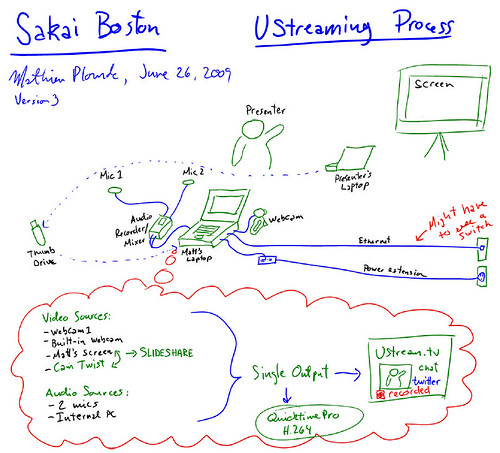
I ended bringing all that stuff to the conference.
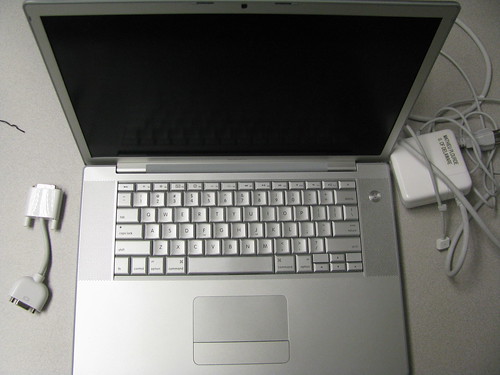
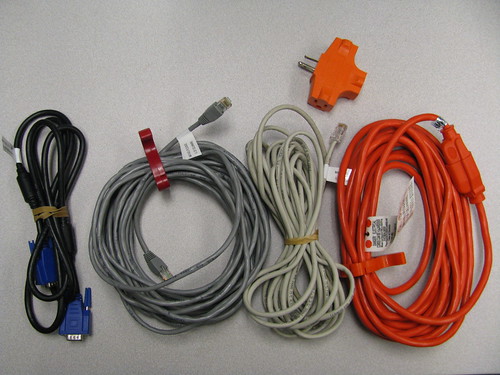
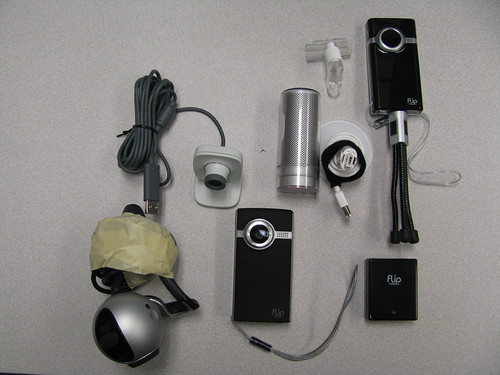
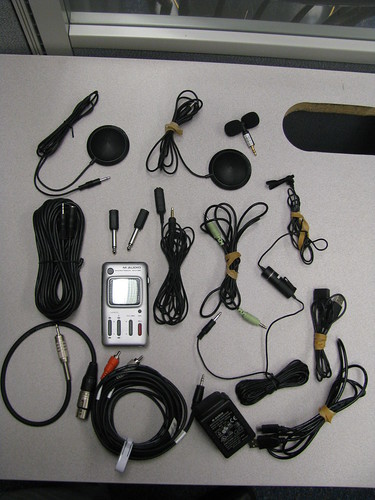
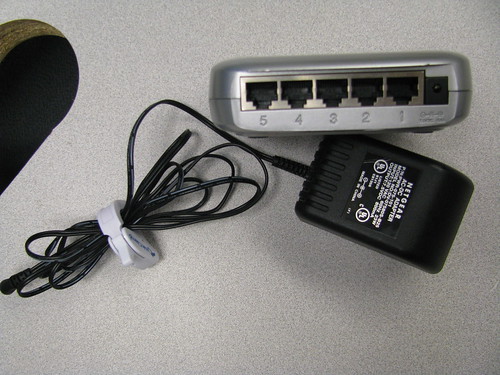
After testing out the external microphones and webcams, I realized during the pre-conference that the internal microphone on my MacBook Pro did a good enough job to avoid carrying the audio recorder with external microphones. Also, the wireless signal was strong enough in session rooms to allow me to avoid being hard-wired. Still, carrying all that stuff around was a challenge, especially since I needed to change rooms, boot-up, get set to stream and record, all of that without slowing down the pace of the conference.
When slides had been uploaded to Ustream prior to the presentation, I was able to switch from the webcams to my shared screen displaying the slides through a free software called CamTwist, which ended up as a way better streaming experience.
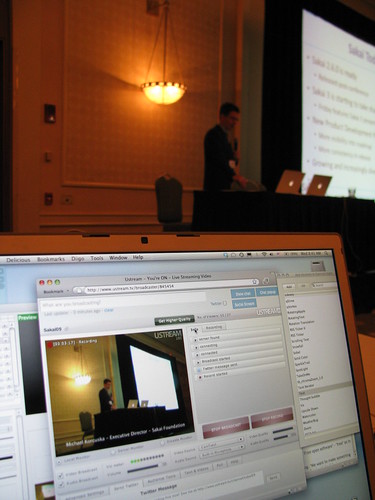
A lot of people at the conference and abroad were thrilled to see that some sessions were streamed, and thanked me profusely for doing this. Attendees also invited at home colleagues to follow the live stream, amplifying the reach of the stream.
Some key stats: more than 22 hours of live streaming, 266 unique viewers, 449 viewers, average of 7.6 viewers at any time, 173 viewer hours, and around 1,000 views of the recordings.
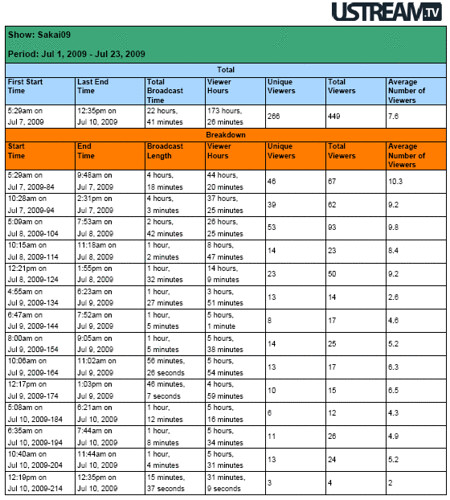
Remember the TWSIA videos? You can compare the quality with the Ustream of the same event.
Lessons Learned
Some lessons learned from this whole experience- Short videos created enough of a buzz to avoid recording every sessions.
- Ustreaming equipment should be left in the rooms that are to be recorded. Moving all this equipement is too cumbersome for a single person.
- Twitter is good for real time social buzz, but sucks at keeping a archive of an event. Search results on Twitter are purged too fast nowadays, Tweets from the conference are not even availble anymore, two weeks after the event. You need to copy the tweets somewhere to make live blogging efficient in the long run, or use a live-blogging tool like CoverItLive during the event.
- When slides are shared in advance, the live streaming experience becomes so much better, because you can switch video sources from webcams to screen sharing, making sure the text and graphics are readable.
- You can't do it alone. It takes a team effort to make something like this happen. More than ten official Citizen Journalists were a part of this initiative, and I personally want to thank them for their support and enthusiasm. See you all next year!

1 comment:
Great post, Mathieu, and a great contribution to the conference. Thanks!
Post a Comment